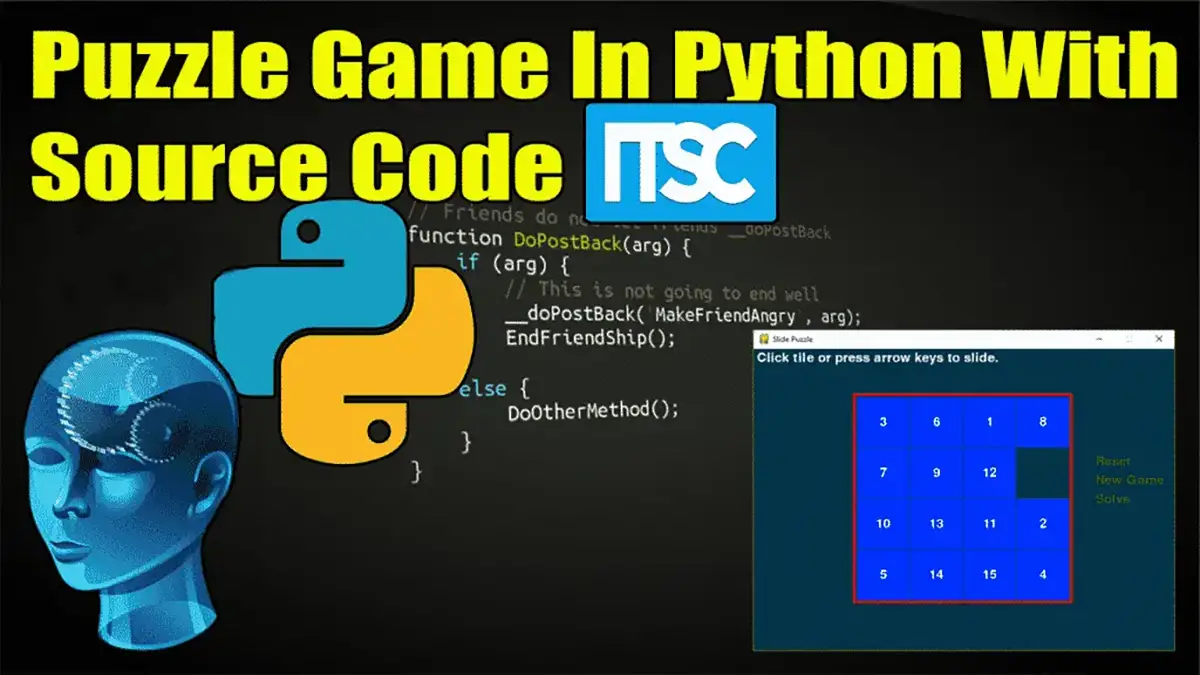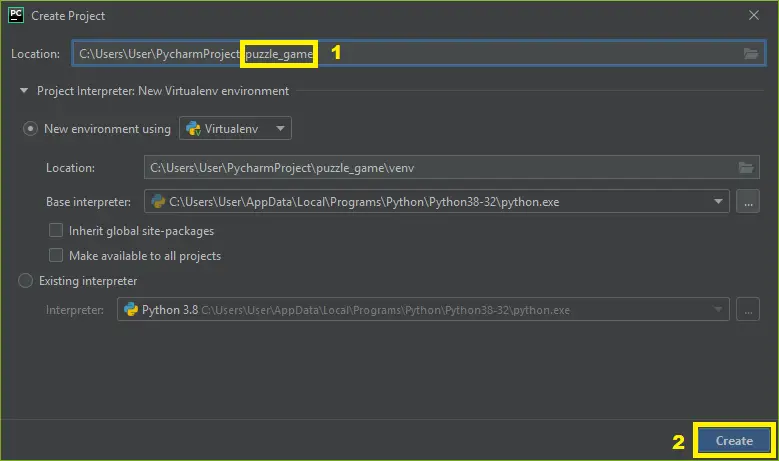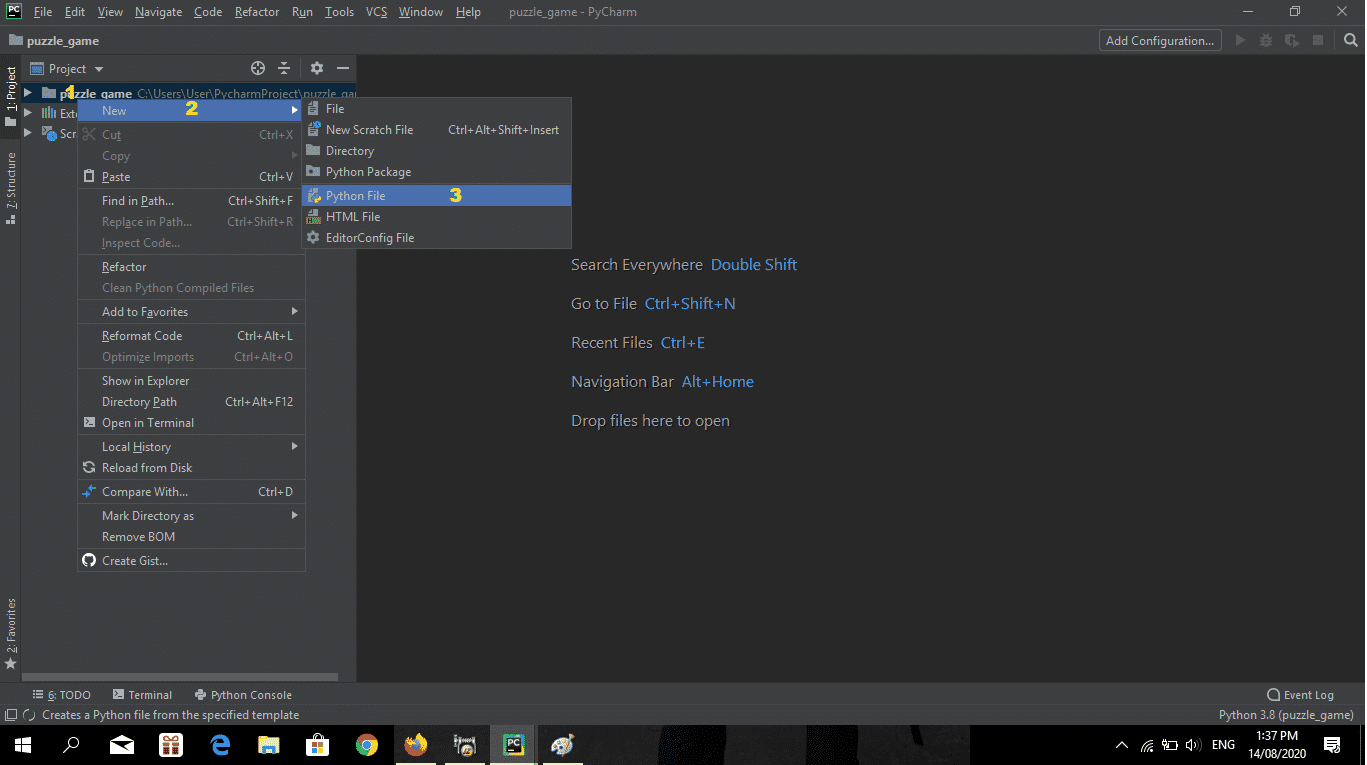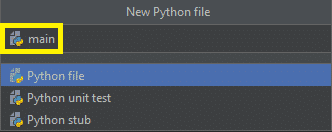The Puzzle Game In Python is written in the Python programming language, Puzzle Game Code In Python, there is a 4*4 board with 15 numbers. The numbers are then shuffled randomly.
In this tutorial, I will teach you how to create a Memory Puzzle Game In Python.
A game Python Puzzle Game has steps to follow, the first is to move the number of tiles into the empty tile space until the tiles are back in their original order from 1 to 15.
Anyway, if you want to level up your knowledge in programming especially games in Python, try this new article I’ve made for you Code For Game in Python: Python Game Projects With Source Code.
This Puzzle Game In Python also includes a downloadable Source Code For Puzzle Game in Python for free, just find the downloadable source code below and click to start downloading.
To start creating a Puzzle Game In Python, make sure that you have PyCharm IDE installed on your computer.
By the way, if you are new to Python programming and don’t know what Python IDE to use, I have here a list of the Best Python IDE for Windows, Linux, and Mac OS that will suit you. I also have here How to Download and Install the Latest Version of Python on Windows.
How to Create a Puzzle Game In Python?
Puzzle Game In Python With Source Code
- Step 1: Create a project name.
First, open Pycharm IDE and then create a “project name” after creating a project name click the “create” button.

- Step 2: Create a python file.
Second, after creating a project name, “right click” your project name and then click “new” after that click the “python file“.

- Step 3: Name your python file.
Third, after creating a Python file, Name your Python file after that click “enter“.

- Step 4: The actual code.
You are free to copy the code given below and download the full source code below.
The Code Given Below Is For Importing Modules or Libraries
import pygame, sys, random
from pygame.locals import *The code is given which is importing all modules or libraries.
The Code Given Below Is For The Design Of The Puzzle
# Create the constants (go ahead and experiment with different values)
BOARDWIDTH = 4 # number of columns in the board
BOARDHEIGHT = 4 # number of rows in the board
TILESIZE = 80
WINDOWWIDTH = 640
WINDOWHEIGHT = 480
FPS = 30
BLANK = None
# R G B
BLACK = ( 0, 0, 0)
WHITE = (255, 255, 255)
BRIGHTBLUE = ( 0, 50, 255)
DARKTURQUOISE = ( 3, 54, 73)
BLUE = ( 0, 50, 255)
GREEN = ( 0, 128, 0)
RED = (255, 0, 0)
BGCOLOR = DARKTURQUOISE
TILECOLOR = BLUE
TEXTCOLOR = WHITE
BORDERCOLOR = RED
BASICFONTSIZE = 20
TEXT = GREEN
BUTTONCOLOR = WHITE
BUTTONTEXTCOLOR = BLACK
MESSAGECOLOR = WHITE
XMARGIN = int((WINDOWWIDTH - (TILESIZE * BOARDWIDTH + (BOARDWIDTH - 1))) / 2)
YMARGIN = int((WINDOWHEIGHT - (TILESIZE * BOARDHEIGHT + (BOARDHEIGHT - 1))) / 2)
UP = 'up'
DOWN = 'down'
LEFT = 'left'
RIGHT = 'right'The code is given which declares the design of the puzzle window, on its size of tiles, color, border, margins, and background color.
The Code Given Below Is For The Main Module
def main():
global FPSCLOCK, DISPLAYSURF, BASICFONT, RESET_SURF, RESET_RECT, NEW_SURF, NEW_RECT, SOLVE_SURF, SOLVE_RECT
pygame.init()
FPSCLOCK = pygame.time.Clock()
DISPLAYSURF = pygame.display.set_mode((WINDOWWIDTH, WINDOWHEIGHT))
pygame.display.set_caption('Slide Puzzle')
BASICFONT = pygame.font.Font('freesansbold.ttf', BASICFONTSIZE)
# Store the option buttons and their rectangles in OPTIONS.
RESET_SURF, RESET_RECT = makeText('Reset', TEXT, BGCOLOR, WINDOWWIDTH - 120, WINDOWHEIGHT - 310)
NEW_SURF, NEW_RECT = makeText('New Game', TEXT, BGCOLOR, WINDOWWIDTH - 120, WINDOWHEIGHT - 280)
SOLVE_SURF, SOLVE_RECT = makeText('Solve', TEXT, BGCOLOR, WINDOWWIDTH - 120, WINDOWHEIGHT - 250)
mainBoard, solutionSeq = generateNewPuzzle(80)
SOLVEDBOARD = getStartingBoard() # a solved board is the same as the board in a start state.
allMoves = [] # list of moves made from the solved configuration
while True: # main game loop
slideTo = None # the direction, if any, a tile should slide
msg = 'Click tile or press arrow keys to slide.' # contains the message to show in the upper left corner.
if mainBoard == SOLVEDBOARD:
msg = 'Solved!'
drawBoard(mainBoard, msg)
checkForQuit()
for event in pygame.event.get(): # event handling loop
if event.type == MOUSEBUTTONUP:
spotx, spoty = getSpotClicked(mainBoard, event.pos[0], event.pos[1])
if (spotx, spoty) == (None, None):
# check if the user clicked on an option button
if RESET_RECT.collidepoint(event.pos):
resetAnimation(mainBoard, allMoves) # clicked on Reset button
allMoves = []
elif NEW_RECT.collidepoint(event.pos):
mainBoard, solutionSeq = generateNewPuzzle(80) # clicked on New Game button
allMoves = []
elif SOLVE_RECT.collidepoint(event.pos):
resetAnimation(mainBoard, solutionSeq + allMoves) # clicked on Solve button
allMoves = []
else:
# check if the clicked tile was next to the blank spot
blankx, blanky = getBlankPosition(mainBoard)
if spotx == blankx + 1 and spoty == blanky:
slideTo = LEFT
elif spotx == blankx - 1 and spoty == blanky:
slideTo = RIGHT
elif spotx == blankx and spoty == blanky + 1:
slideTo = UP
elif spotx == blankx and spoty == blanky - 1:
slideTo = DOWN
elif event.type == KEYUP:
# check if the user pressed a key to slide a tile
if event.key in (K_LEFT, K_a) and isValidMove(mainBoard, LEFT):
slideTo = LEFT
elif event.key in (K_RIGHT, K_d) and isValidMove(mainBoard, RIGHT):
slideTo = RIGHT
elif event.key in (K_UP, K_w) and isValidMove(mainBoard, UP):
slideTo = UP
elif event.key in (K_DOWN, K_s) and isValidMove(mainBoard, DOWN):
slideTo = DOWN
if slideTo:
slideAnimation(mainBoard, slideTo, 'Click tile or press arrow keys to slide.', 8) # show slide on screen
makeMove(mainBoard, slideTo)
allMoves.append(slideTo) # record the slide
pygame.display.update()
FPSCLOCK.tick(FPS)This module is the main module of the puzzle game.
The Code Given Below Is The Module Exit
def terminate():
pygame.quit()
sys.exit()In this module which is the exit module of the puzzle game.
The Code Given Below Is For The Making Move Module
def makeMove(board, move):
# This function does not check if the move is valid.
blankx, blanky = getBlankPosition(board)
if move == UP:
board[blankx][blanky], board[blankx][blanky + 1] = board[blankx][blanky + 1], board[blankx][blanky]
elif move == DOWN:
board[blankx][blanky], board[blankx][blanky - 1] = board[blankx][blanky - 1], board[blankx][blanky]
elif move == LEFT:
board[blankx][blanky], board[blankx + 1][blanky] = board[blankx + 1][blanky], board[blankx][blanky]
elif move == RIGHT:
board[blankx][blanky], board[blankx - 1][blanky] = board[blankx - 1][blanky], board[blankx][blanky]In this module which is the condition when a player makes a move.
The Code Given Below Is For The Random Move Module
def getRandomMove(board, lastMove=None):
# start with a full list of all four moves
validMoves = [UP, DOWN, LEFT, RIGHT]
# remove moves from the list as they are disqualified
if lastMove == UP or not isValidMove(board, DOWN):
validMoves.remove(DOWN)
if lastMove == DOWN or not isValidMove(board, UP):
validMoves.remove(UP)
if lastMove == LEFT or not isValidMove(board, RIGHT):
validMoves.remove(RIGHT)
if lastMove == RIGHT or not isValidMove(board, LEFT):
validMoves.remove(LEFT)
# return a random move from the list of remaining moves
return random.choice(validMoves)In this module which is getting the random move.
The Code Given Below Is For The Generate New Puzzle Module
def generateNewPuzzle(numSlides):
# From a starting configuration, make numSlides number of moves (and
# animate these moves).
sequence = []
board = getStartingBoard()
drawBoard(board, '')
pygame.display.update()
pygame.time.wait(500) # pause 500 milliseconds for effect
lastMove = None
for i in range(numSlides):
move = getRandomMove(board, lastMove)
slideAnimation(board, move, 'Generating new puzzle...', animationSpeed=int(TILESIZE / 3))
makeMove(board, move)
sequence.append(move)
lastMove = move
return (board, sequence)In this module which is generating new puzzles.
Complete Source Code
import pygame, sys, random
from pygame.locals import *
# Create the constants (go ahead and experiment with different values)
BOARDWIDTH = 4 # number of columns in the board
BOARDHEIGHT = 4 # number of rows in the board
TILESIZE = 80
WINDOWWIDTH = 640
WINDOWHEIGHT = 480
FPS = 30
BLANK = None
# R G B
BLACK = ( 0, 0, 0)
WHITE = (255, 255, 255)
BRIGHTBLUE = ( 0, 50, 255)
DARKTURQUOISE = ( 3, 54, 73)
BLUE = ( 0, 50, 255)
GREEN = ( 0, 128, 0)
RED = (255, 0, 0)
BGCOLOR = DARKTURQUOISE
TILECOLOR = BLUE
TEXTCOLOR = WHITE
BORDERCOLOR = RED
BASICFONTSIZE = 20
TEXT = GREEN
BUTTONCOLOR = WHITE
BUTTONTEXTCOLOR = BLACK
MESSAGECOLOR = WHITE
XMARGIN = int((WINDOWWIDTH - (TILESIZE * BOARDWIDTH + (BOARDWIDTH - 1))) / 2)
YMARGIN = int((WINDOWHEIGHT - (TILESIZE * BOARDHEIGHT + (BOARDHEIGHT - 1))) / 2)
UP = 'up'
DOWN = 'down'
LEFT = 'left'
RIGHT = 'right'
def main():
global FPSCLOCK, DISPLAYSURF, BASICFONT, RESET_SURF, RESET_RECT, NEW_SURF, NEW_RECT, SOLVE_SURF, SOLVE_RECT
pygame.init()
FPSCLOCK = pygame.time.Clock()
DISPLAYSURF = pygame.display.set_mode((WINDOWWIDTH, WINDOWHEIGHT))
pygame.display.set_caption('Slide Puzzle')
BASICFONT = pygame.font.Font('freesansbold.ttf', BASICFONTSIZE)
# Store the option buttons and their rectangles in OPTIONS.
RESET_SURF, RESET_RECT = makeText('Reset', TEXT, BGCOLOR, WINDOWWIDTH - 120, WINDOWHEIGHT - 310)
NEW_SURF, NEW_RECT = makeText('New Game', TEXT, BGCOLOR, WINDOWWIDTH - 120, WINDOWHEIGHT - 280)
SOLVE_SURF, SOLVE_RECT = makeText('Solve', TEXT, BGCOLOR, WINDOWWIDTH - 120, WINDOWHEIGHT - 250)
mainBoard, solutionSeq = generateNewPuzzle(80)
SOLVEDBOARD = getStartingBoard() # a solved board is the same as the board in a start state.
allMoves = [] # list of moves made from the solved configuration
while True: # main game loop
slideTo = None # the direction, if any, a tile should slide
msg = 'Click tile or press arrow keys to slide.' # contains the message to show in the upper left corner.
if mainBoard == SOLVEDBOARD:
msg = 'Solved!'
drawBoard(mainBoard, msg)
checkForQuit()
for event in pygame.event.get(): # event handling loop
if event.type == MOUSEBUTTONUP:
spotx, spoty = getSpotClicked(mainBoard, event.pos[0], event.pos[1])
if (spotx, spoty) == (None, None):
# check if the user clicked on an option button
if RESET_RECT.collidepoint(event.pos):
resetAnimation(mainBoard, allMoves) # clicked on Reset button
allMoves = []
elif NEW_RECT.collidepoint(event.pos):
mainBoard, solutionSeq = generateNewPuzzle(80) # clicked on New Game button
allMoves = []
elif SOLVE_RECT.collidepoint(event.pos):
resetAnimation(mainBoard, solutionSeq + allMoves) # clicked on Solve button
allMoves = []
else:
# check if the clicked tile was next to the blank spot
blankx, blanky = getBlankPosition(mainBoard)
if spotx == blankx + 1 and spoty == blanky:
slideTo = LEFT
elif spotx == blankx - 1 and spoty == blanky:
slideTo = RIGHT
elif spotx == blankx and spoty == blanky + 1:
slideTo = UP
elif spotx == blankx and spoty == blanky - 1:
slideTo = DOWN
elif event.type == KEYUP:
# check if the user pressed a key to slide a tile
if event.key in (K_LEFT, K_a) and isValidMove(mainBoard, LEFT):
slideTo = LEFT
elif event.key in (K_RIGHT, K_d) and isValidMove(mainBoard, RIGHT):
slideTo = RIGHT
elif event.key in (K_UP, K_w) and isValidMove(mainBoard, UP):
slideTo = UP
elif event.key in (K_DOWN, K_s) and isValidMove(mainBoard, DOWN):
slideTo = DOWN
if slideTo:
slideAnimation(mainBoard, slideTo, 'Click tile or press arrow keys to slide.', 8) # show slide on screen
makeMove(mainBoard, slideTo)
allMoves.append(slideTo) # record the slide
pygame.display.update()
FPSCLOCK.tick(FPS)
def terminate():
pygame.quit()
sys.exit()
def checkForQuit():
for event in pygame.event.get(QUIT): # get all the QUIT events
terminate() # terminate if any QUIT events are present
for event in pygame.event.get(KEYUP): # get all the KEYUP events
if event.key == K_ESCAPE:
terminate() # terminate if the KEYUP event was for the Esc key
pygame.event.post(event) # put the other KEYUP event objects back
def getStartingBoard():
# Return a board data structure with tiles in the solved state.
# For example, if BOARDWIDTH and BOARDHEIGHT are both 3, this function
# returns [[1, 4, 7], [2, 5, 8], [3, 6, BLANK]]
counter = 1
board = []
for x in range(BOARDWIDTH):
column = []
for y in range(BOARDHEIGHT):
column.append(counter)
counter += BOARDWIDTH
board.append(column)
counter -= BOARDWIDTH * (BOARDHEIGHT - 1) + BOARDWIDTH - 1
board[BOARDWIDTH-1][BOARDHEIGHT-1] = BLANK
return board
def getBlankPosition(board):
# Return the x and y of board coordinates of the blank space.
for x in range(BOARDWIDTH):
for y in range(BOARDHEIGHT):
if board[x][y] == BLANK:
return (x, y)
def makeMove(board, move):
# This function does not check if the move is valid.
blankx, blanky = getBlankPosition(board)
if move == UP:
board[blankx][blanky], board[blankx][blanky + 1] = board[blankx][blanky + 1], board[blankx][blanky]
elif move == DOWN:
board[blankx][blanky], board[blankx][blanky - 1] = board[blankx][blanky - 1], board[blankx][blanky]
elif move == LEFT:
board[blankx][blanky], board[blankx + 1][blanky] = board[blankx + 1][blanky], board[blankx][blanky]
elif move == RIGHT:
board[blankx][blanky], board[blankx - 1][blanky] = board[blankx - 1][blanky], board[blankx][blanky]
def isValidMove(board, move):
blankx, blanky = getBlankPosition(board)
return (move == UP and blanky != len(board[0]) - 1) or \
(move == DOWN and blanky != 0) or \
(move == LEFT and blankx != len(board) - 1) or \
(move == RIGHT and blankx != 0)
def getRandomMove(board, lastMove=None):
# start with a full list of all four moves
validMoves = [UP, DOWN, LEFT, RIGHT]
# remove moves from the list as they are disqualified
if lastMove == UP or not isValidMove(board, DOWN):
validMoves.remove(DOWN)
if lastMove == DOWN or not isValidMove(board, UP):
validMoves.remove(UP)
if lastMove == LEFT or not isValidMove(board, RIGHT):
validMoves.remove(RIGHT)
if lastMove == RIGHT or not isValidMove(board, LEFT):
validMoves.remove(LEFT)
# return a random move from the list of remaining moves
return random.choice(validMoves)
def getLeftTopOfTile(tileX, tileY):
left = XMARGIN + (tileX * TILESIZE) + (tileX - 1)
top = YMARGIN + (tileY * TILESIZE) + (tileY - 1)
return (left, top)
def getSpotClicked(board, x, y):
# from the x & y pixel coordinates, get the x & y board coordinates
for tileX in range(len(board)):
for tileY in range(len(board[0])):
left, top = getLeftTopOfTile(tileX, tileY)
tileRect = pygame.Rect(left, top, TILESIZE, TILESIZE)
if tileRect.collidepoint(x, y):
return (tileX, tileY)
return (None, None)
def drawTile(tilex, tiley, number, adjx=0, adjy=0):
# draw a tile at board coordinates tilex and tiley, optionally a few
# pixels over (determined by adjx and adjy)
left, top = getLeftTopOfTile(tilex, tiley)
pygame.draw.rect(DISPLAYSURF, TILECOLOR, (left + adjx, top + adjy, TILESIZE, TILESIZE))
textSurf = BASICFONT.render(str(number), True, TEXTCOLOR)
textRect = textSurf.get_rect()
textRect.center = left + int(TILESIZE / 2) + adjx, top + int(TILESIZE / 2) + adjy
DISPLAYSURF.blit(textSurf, textRect)
def makeText(text, color, bgcolor, top, left):
# create the Surface and Rect objects for some text.
textSurf = BASICFONT.render(text, True, color, bgcolor)
textRect = textSurf.get_rect()
textRect.topleft = (top, left)
return (textSurf, textRect)
def drawBoard(board, message):
DISPLAYSURF.fill(BGCOLOR)
if message:
textSurf, textRect = makeText(message, MESSAGECOLOR, BGCOLOR, 5, 5)
DISPLAYSURF.blit(textSurf, textRect)
for tilex in range(len(board)):
for tiley in range(len(board[0])):
if board[tilex][tiley]:
drawTile(tilex, tiley, board[tilex][tiley])
left, top = getLeftTopOfTile(0, 0)
width = BOARDWIDTH * TILESIZE
height = BOARDHEIGHT * TILESIZE
pygame.draw.rect(DISPLAYSURF, BORDERCOLOR, (left - 5, top - 5, width + 11, height + 11), 4)
DISPLAYSURF.blit(RESET_SURF, RESET_RECT)
DISPLAYSURF.blit(NEW_SURF, NEW_RECT)
DISPLAYSURF.blit(SOLVE_SURF, SOLVE_RECT)
def slideAnimation(board, direction, message, animationSpeed):
# Note: This function does not check if the move is valid.
blankx, blanky = getBlankPosition(board)
if direction == UP:
movex = blankx
movey = blanky + 1
elif direction == DOWN:
movex = blankx
movey = blanky - 1
elif direction == LEFT:
movex = blankx + 1
movey = blanky
elif direction == RIGHT:
movex = blankx - 1
movey = blanky
# prepare the base surface
drawBoard(board, message)
baseSurf = DISPLAYSURF.copy()
# draw a blank space over the moving tile on the baseSurf Surface.
moveLeft, moveTop = getLeftTopOfTile(movex, movey)
pygame.draw.rect(baseSurf, BGCOLOR, (moveLeft, moveTop, TILESIZE, TILESIZE))
for i in range(0, TILESIZE, animationSpeed):
# animate the tile sliding over
checkForQuit()
DISPLAYSURF.blit(baseSurf, (0, 0))
if direction == UP:
drawTile(movex, movey, board[movex][movey], 0, -i)
if direction == DOWN:
drawTile(movex, movey, board[movex][movey], 0, i)
if direction == LEFT:
drawTile(movex, movey, board[movex][movey], -i, 0)
if direction == RIGHT:
drawTile(movex, movey, board[movex][movey], i, 0)
pygame.display.update()
FPSCLOCK.tick(FPS)
def generateNewPuzzle(numSlides):
# From a starting configuration, make numSlides number of moves (and
# animate these moves).
sequence = []
board = getStartingBoard()
drawBoard(board, '')
pygame.display.update()
pygame.time.wait(500) # pause 500 milliseconds for effect
lastMove = None
for i in range(numSlides):
move = getRandomMove(board, lastMove)
slideAnimation(board, move, 'Generating new puzzle...', animationSpeed=int(TILESIZE / 3))
makeMove(board, move)
sequence.append(move)
lastMove = move
return (board, sequence)
def resetAnimation(board, allMoves):
# make all of the moves in allMoves in reverse.
revAllMoves = allMoves[:] # gets a copy of the list
revAllMoves.reverse()
for move in revAllMoves:
if move == UP:
oppositeMove = DOWN
elif move == DOWN:
oppositeMove = UP
elif move == RIGHT:
oppositeMove = LEFT
elif move == LEFT:
oppositeMove = RIGHT
slideAnimation(board, oppositeMove, '', animationSpeed=int(TILESIZE / 2))
makeMove(board, oppositeMove)
if __name__ == '__main__':
main()Output
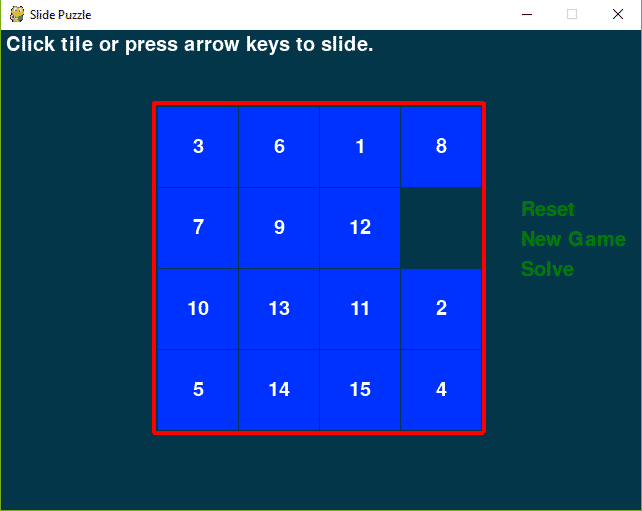
Puzzle Game In Python: Project Information
| Project Name: | Puzzle Game In Python |
| Language/s Used: | Python (GUI) Based |
| Python version (Recommended): | 2.x or 3.x |
| Database: | None |
| Type: | Python App |
| Developer: | IT SOURCECODE |
| Updates: | 0 |
Downloadable Source Code
I have here the list of Best Python Projects with Source code free to download for free, I hope this can help you a lot.
Summary
The Puzzle Game In Python is written in Python programming language, Python is very easy to research the syntax emphasizes readability and it is able to reduce time ingesting in developing.
Also, this tutorial is the simplest way for beginners or students to enhance their logical skills in programming. Also, this game project is a way for students or beginners to design and develop games.
Related Articles
- Tank Game Python with Source Code
- Tetris In Python Code
- Mario Game In Python With Source Code
- Hangman Game In Python With Source Code
- Aircraft War Game in Python with Source Code
- Snake Game In Python Code
Inquiries
If you have any questions or suggestions about Puzzle Game In Python, please feel free to leave a comment below.

